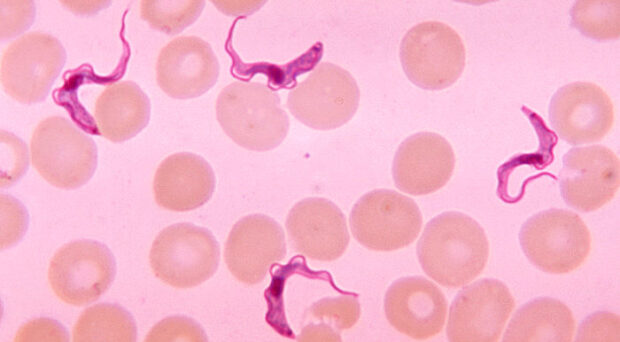The prospect of a better treatment for Chagas disease and human African sleeping sickness
BugBitten The prospect of a better treatment for Chagas disease and ... BMC Blogs Network


The Neglected Tropical Diseases and the Sustainable Development Goals (SDGs)

Introduction
The group of neglected tropical diseases caused by single-celled, flagellate parasites (the trypanosomatids) include Chagas disease, human African sleeping sickness, and leishmaniasis. These diseases have been a challenge to treat, but recent research has shown promising results in the development of new drugs.
Identification of Compounds with Trypanocidal Activity
A recent study published in Science describes the identification of a class of compounds that rapidly kill trypanosomes, the parasites responsible for these diseases.
- With the help of automation and miniaturization techniques, Shrinivasa Rao and colleagues performed whole-cell high-throughput screening of the Novartis compound collection with cultures of trypanosomes. They identified cyanotriazole0 (CT0), a compound belonging to the cyanotriazole (CT) group that proved to be potent growth inhibitors of trypanosomatids.
- CT0 had limitations for in vivo use due to its limited solubility and poor oral bioavailability and brain exposure. The group modified the molecule to produce CT1 and CT3, which were suitable for in vivo assessment.
- CT3 was tested in mouse models for Chagas disease and human African trypanosomiasis. It effectively eliminated parasites in both cases.
The Mechanism of Action of CT3
The group used several approaches to determine the mode of action of CT1 and CT3:
- Observation of the cell cycle of trypanosomes showed that DNA replication in the nucleus, but not the kinetoplast, was inhibited. Metabolomic analysis revealed an increase in deoxynucleotide abundance, indicating possible DNA damage.
- Immunoblotting and in situ fluorescent microscopy showed an increase in double-stranded DNA breaks.
- Drug-resistant mutants were selected and whole-genome sequencing identified a single-nucleotide polymorphism in the topoisomerase II alpha gene (topoIIα) that was common to all mutants.
- Topoisomerase II alpha (TopoIIα) was identified as the site of action of the CTs. Introduction of the drug-resistant allele into trypanosomes confirmed TopoIIα as the drug target.
- A TopoII cleavage assay showed that CT1 and CT3 stabilized the topoisomerase dsDNA cleavage complex, preventing the DNA from returning to a supercoiled form.
- The structure of the TopoII DNA binding domain bound to dsDNA and CT1 was solved using cryo–electron microscopy.
The Future
This comprehensive research project has demonstrated that cyanotriazoles are selective topoisomerase II poisons. They effectively inhibit the growth of kinetoplastid parasites in vitro and eliminate the agents of Chagas disease and human African trypanosomiasis in mouse models. The group is now working to identify suitable clinical candidates and is confident that their findings will help improve the treatment of these neglected tropical diseases, contributing to the achievement of the Sustainable Development Goals.
SDGs, Targets, and Indicators
1. Which SDGs are addressed or connected to the issues highlighted in the article?
- SDG 3: Good Health and Well-being
- SDG 9: Industry, Innovation, and Infrastructure
- SDG 17: Partnerships for the Goals
The article discusses neglected tropical diseases caused by trypanosomatids, such as Chagas disease, human African sleeping sickness, and leishmaniasis. These diseases are directly related to SDG 3, which aims to ensure healthy lives and promote well-being for all at all ages. The article also mentions progress in the improvement of treatment through chemical library screens, which connects to SDG 9, which focuses on promoting sustainable industrialization and fostering innovation. Additionally, the research project mentioned in the article involves collaboration between multiple authors and institutions, highlighting the importance of partnerships for achieving the goals outlined in SDG 17.
2. What specific targets under those SDGs can be identified based on the article’s content?
- Target 3.3: By 2030, end the epidemics of AIDS, tuberculosis, malaria, and neglected tropical diseases and combat hepatitis, water-borne diseases, and other communicable diseases.
- Target 9.5: Enhance scientific research, upgrade the technological capabilities of industrial sectors in all countries, in particular developing countries, including, by 2030, encouraging innovation and substantially increasing the number of research and development workers per 1 million people and public and private research and development spending.
- Target 17.16: Enhance the global partnership for sustainable development, complemented by multi-stakeholder partnerships that mobilize and share knowledge, expertise, technology, and financial resources, to support the achievement of the sustainable development goals in all countries, in particular developing countries.
Based on the article’s content, the specific targets that can be identified are Target 3.3, which aims to end the epidemics of neglected tropical diseases, and Target 9.5, which focuses on enhancing scientific research and technological capabilities. The collaboration between authors and institutions mentioned in the article also aligns with Target 17.16, which emphasizes the importance of global partnerships for sustainable development.
3. Are there any indicators mentioned or implied in the article that can be used to measure progress towards the identified targets?
- Indicator 3.3.1: Number of new cases of selected neglected tropical diseases per 100,000 population.
- Indicator 9.5.1: Research and development expenditure as a proportion of GDP.
- Indicator 17.16.1: Number of countries reporting progress in multi-stakeholder development effectiveness monitoring frameworks that support the achievement of the sustainable development goals.
The article does not explicitly mention specific indicators for measuring progress towards the identified targets. However, potential indicators that can be used include Indicator 3.3.1, which measures the number of new cases of neglected tropical diseases, Indicator 9.5.1, which assesses research and development expenditure as a proportion of GDP, and Indicator 17.16.1, which tracks the number of countries reporting progress in multi-stakeholder development effectiveness monitoring frameworks.
4. Table: SDGs, Targets, and Indicators
| SDGs | Targets | Indicators |
|---|---|---|
| SDG 3: Good Health and Well-being | Target 3.3: By 2030, end the epidemics of AIDS, tuberculosis, malaria, and neglected tropical diseases and combat hepatitis, water-borne diseases, and other communicable diseases. | Indicator 3.3.1: Number of new cases of selected neglected tropical diseases per 100,000 population. |
| SDG 9: Industry, Innovation, and Infrastructure | Target 9.5: Enhance scientific research, upgrade the technological capabilities of industrial sectors in all countries, in particular developing countries, including, by 2030, encouraging innovation and substantially increasing the number of research and development workers per 1 million people and public and private research and development spending. | Indicator 9.5.1: Research and development expenditure as a proportion of GDP. |
| SDG 17: Partnerships for the Goals | Target 17.16: Enhance the global partnership for sustainable development, complemented by multi-stakeholder partnerships that mobilize and share knowledge, expertise, technology, and financial resources, to support the achievement of the sustainable development goals in all countries, in particular developing countries. | Indicator 17.16.1: Number of countries reporting progress in multi-stakeholder development effectiveness monitoring frameworks that support the achievement of the sustainable development goals. |
Behold! This splendid article springs forth from the wellspring of knowledge, shaped by a wondrous proprietary AI technology that delved into a vast ocean of data, illuminating the path towards the Sustainable Development Goals. Remember that all rights are reserved by SDG Investors LLC, empowering us to champion progress together.
Source: blogs.biomedcentral.com

Join us, as fellow seekers of change, on a transformative journey at https://sdgtalks.ai/welcome, where you can become a member and actively contribute to shaping a brighter future.







